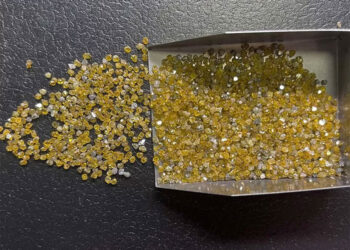Our Services
Contact info
We are always ready to help you. There are many ways to contact us. You may drop us a line, give us a call or send an email, choose what suits you most.
Need help?
15 W 47th St Suite #200 Second Floor, New York, 10036,United States
Tel: +1 917 302 9305
[email protected]
Exploring the Construction Field With Lab Grown Diamonds
The rapid growth of the construction industry is one of the major factors driving the global demand for lab-grown diamonds. These diamonds are used in various applications such as cutting, drilling, grinding, and polishing. The construction industry is growing due to rising urbanization and the government’s focus on infrastructure development. Moreover, the government has allocated USD 92.2 billion for boosting infrastructure development in India.
The rapid expansion of the construction and mining industries in Asia-Pacific is driving the demand for lab-grown diamonds. In addition to being more affordable than natural diamonds, they can also be used in a variety of applications. They are ideal for many types of construction and engineering projects.
While they are less expensive than natural diamonds, lab-grown diamonds do not retain their value as long. By 2050, the world’s natural diamond supply may reach its maximum, which will likely create a severe shortage. In the next decade, experts predict that natural diamonds will lose 15 million carats a year. A shortage like this will only intensify the demand for lab-grown diamonds.
Environmental impact of lab-grown diamonds
The use of lab-grown diamonds is gaining ground in the construction and stone field. Despite its recent rise in popularity, the mined diamond industry is facing issues such as oversupply and a drop in demand. In China alone, sales of mined diamonds fell 5% last year. De Beers, the world’s largest diamond manufacturer, recently announced a 15% production cut due to weak prices.
Although the mining industry has pushed back against lab-grown stones, the popularity and awareness of them has steadily increased. One study released by MVI Marketing in 2018 shows that 80 percent of consumers are aware of the difference between natural and lab-grown diamonds. As a result, the lab-grown diamond industry is on the verge of claiming even more market share. Many consumers are attracted to the size-to-value equation. A larger lab-grown diamond is more desirable to couples than a smaller stone.
-
1
When compared to mined diamonds, lab-grown diamonds have a far less significant environmental impact. Mining involves the use of heavy machinery, explosives, hydraulic equipment, and other harsh techniques to dig deep. The result is a significant amount of mineral waste and disturbed ecosystems. Additionally, mines are dangerous for workers and pose a variety of health risks.
-
2
Environmental impact of construction with lab-grown diamonds may be difficult to measure but the process can be more beneficial to the environment than traditional diamond mining. Diamond mining involves large amounts of hydrocarbons, electricity, water, and chemical waste. The process can also produce dangerous chemicals that harm the environment.
-
3
While there are concerns regarding the safety of diamond mining, many companies have taken steps to improve the process. However, some diamond-growing processes use enormous amounts of energy and chemicals. The FTC, for example, has warned about claims of sustainable diamonds. Despite this, most lab-grown diamonds are similar to natural diamonds in both chemical and physical properties. They also have the same carbon-crystal structure and can cost as much as 40 percent less than their natural counterparts.
-
4
The environmental impact of lab-grown diamonds is still unknown, but mining companies are attempting to minimize the damage. The company is using renewable energy to generate these diamonds, but these practices do not have zero impact on the environment. This is a major concern for the mining industry, as they affect local communities and fish.
-
5
Diamond mining has a huge environmental impact, polluting air with carbon dioxide and water. In addition, mining operations often distort rivers and cause a ripple effect on fish and other aquatic creatures. Furthermore, abandoned mines often become mosquito breeding grounds. Lastly, the mining process consumes large amounts of water, which can adversely impact human health.
-
6
Although the production of lab-grown diamonds is a good way to reduce carbon pollution, the production of these diamonds can be quite expensive. In addition to causing damage to the environment, diamond-growing facilities consume vast amounts of energy and fossil fuels.
Application of lab-grown diamonds
-
1
The term "lab-grown diamond" is a bit misleading, because it's not actually real diamond. It's a synthetic one created in a lab and does not come from a mine. However, it is a popular choice among consumers for jewelry. It's also more affordable and environmentally friendly. Many jewelry makers have begun using these diamonds in their products, and the trend seems to be increasing.
-
2
De Beers, the world's largest natural diamond miner and retailer, has recently invested $100 million in a new lab that will grow lab-grown diamonds. The company plans to target Millennials, who often shy away from natural stones for the high price tag. The company hopes to gain market share from this new trend by providing affordable alternatives.
-
3
The report also explores the market dynamics of lab-grown diamonds and analyzes future predictions. It also identifies growth opportunities and highlights key product positioning. It also includes a competitive analysis of the key players in the field. Further, the report includes detailed information about the industry, including the key players and the market size.
-
4
While lab-grown diamonds are more affordable than mined diamonds, they won't maintain their value as long as natural diamonds do. Natural diamonds are a finite natural resource, and their rarity is one of their best assets for long-term value. As a result, many experts predict a shortage of 15 million carats of natural diamonds in the next decade, creating a demand for lab-grown diamonds.
-
5
Lab-grown diamonds are used in a variety of applications. Some of these applications have been around for a long time, while others have recently emerged as a result of research. Traditional industrial applications for diamonds include cutting, drilling, and mining. HPHT diamonds are used in optics. While the industrial field is still the most common, newer uses are emerging.
-
6
Lab-grown diamonds are available in a wide range of shapes, sizes, and qualities. In addition to being environmentally friendly, they are also highly economical.
Related Projects

lab grown diamonds
Nanometer Modified Diamond Powder

lab grown diamonds
CVD SC Diamond Optical Window

lab grown diamonds
HPHT Monocrystalline Diamonds




